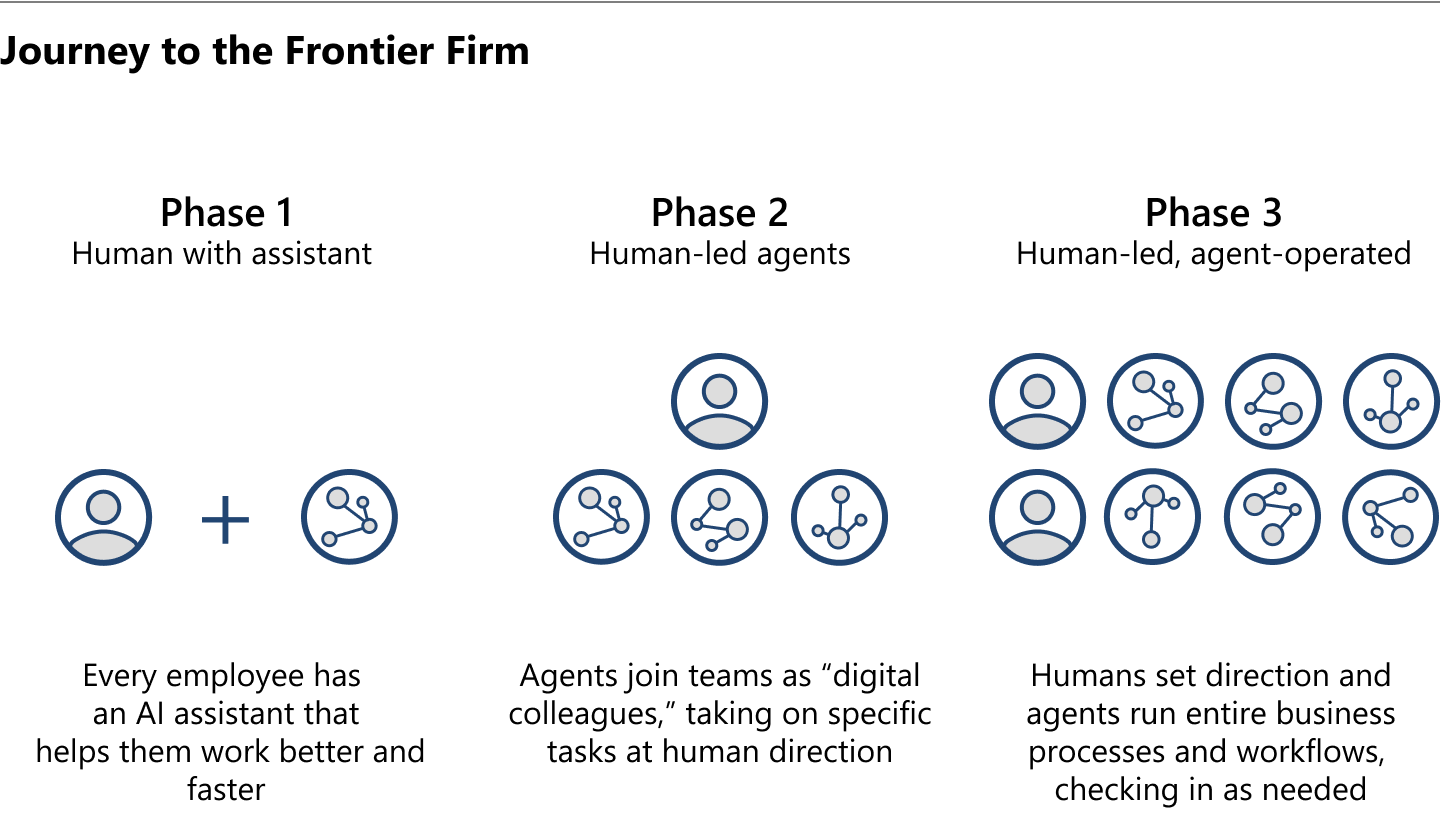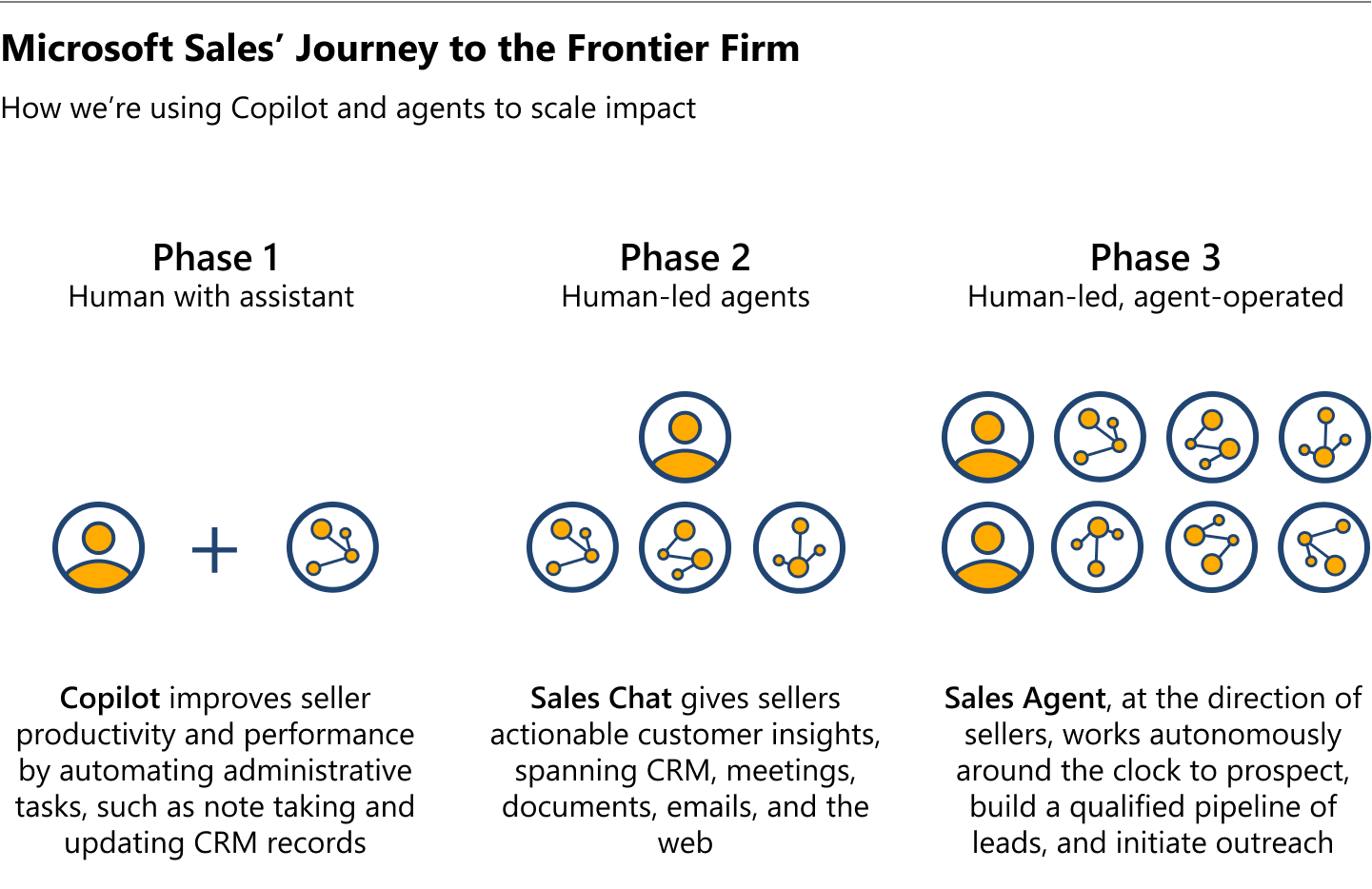Illustration by Alex Robbins
Imagine stepping onto a steamship along the Hudson River in 1900, setting off on a transatlantic journey that will take a full week. You turn to a fellow passenger and say, “In just a few decades, this same trip will take seven hours—and we’ll do it in the sky.” You’d likely be met with polite disbelief, maybe even a chuckle. The idea would sound more like fantasy than foresight. And yet, that’s exactly what happened. What once seemed impossible quickly became the new normal.
And that’s about to happen with AI and business, but with once unimaginable progress compressed into a few years instead of decades. Many organizations are in the initial phase of AI transformation, with humans tapping AI as an assistant. Some have already reached the second phase, forming teams of humans and agents working together toward common goals.
But phase three, the Frontier Firm, where humans empower AI to become the operational engine of business—and agents become the primary producers of work—is harder to envision. It’s “imagining the impossible” territory. And the main barrier to getting there is not the limits of technology; it’s the challenge of imagining a totally new way to work and structure organizations, then figuring out how to execute that transformation.

The three phases of AI transformation
As we said last month in the 2025 Work Trend Index Annual Report, we see organizations moving through three phases on their way to becoming entirely new businesses, powered by intelligence on demand. Knowledge workers will no longer handle all knowledge work, with agents executing more and more of it. Human roles will refocus around vision, strategy, relationship building, and managing agents.
At Microsoft, we’re not just talking about this transformation—we’re living it. Our sales organization is actively navigating all three phases at once. By testing and scaling new tools like Microsoft 365 Copilot, Sales Chat, and our autonomous Sales Agent, we’re learning what works, where the friction points are, and how to evolve both our technology and our ways of working. These internal experiences are helping us refine the path forward—not just for ourselves, but for every organization on this journey.
“The core of what makes a good seller hasn’t changed,” says Pam Maynard, our Chief AI Transformation Officer for Microsoft Commercial. “They deeply understand the customer’s context, priorities, and pain points, and then map our solutions to those needs.” Increasingly, that will come from hybrid teams of humans + agents.
Phase 1: Human with assistant
Every employee uses AI as a personal assistant to work better and faster—writing, analyzing data, generating code. This is about productivity on a personal level rather than team or organizational. At scale, the impact means organizations working in the same way, using the same processes but more efficiently. In phase one, humans still drive the work.
For our sales organization, this step has focused on high-volume tasks: the administrative work that sellers often repeat dozens of times a day, like updating CRM records or taking meeting notes. “Copilot tackles the administrative minutiae so sellers can spend more time connecting with customers,” Maynard says.
The results? One sales team of nearly 700 people has already reported 9.4% higher revenue per person and 20% more deals closed compared to their peers with lower Copilot usage1—concrete gains that show how AI is driving real business outcomes.
Phase 2: Human-agent teams
Agents join the team as digital colleagues, taking on specific tasks at human direction—triaging support tickets, handling project management, facilitating meetings, contributing to brainstorming sessions. Agents boost efficiency and productivity at the team level, augment employees with new skills, and free them up to take on new, more valuable tasks.
At Microsoft, this shift is embodied in Sales Chat, an extension of Copilot that brings rich CRM and sales context directly into the seller’s workflow. Instead of toggling between dozens of tools to prepare for a customer meeting, sellers can now get instant access to detailed account and opportunity information, including licensing details, renewal timelines, and key decision-makers. It also surfaces high-level account summaries and revenue breakdowns, gives real-time coaching, and provides predictive insights to forecast deal outcomes and suggest next steps. “Before Sales Chat, sellers had to swivel between 20 different tools just to get the full picture,” Maynard says. “Now they can simply ask, ‘What do I need to know before my meeting with this customer?’ and get everything in one place. It points them straight to the highest-value action they can take.”
Phase 3: Human-led, agent-operated
Humans define strategy and assign goals to agents. These agents work mostly with other agents to perform complex operations, escalating issues to humans for guidance when necessary. Agents will design workflows and even evaluate one another. Humans will monitor their progress through dashboards that summarize agentic activities, intervening only for critical decisions. We’ll see the emergence of a new career opportunity for humans in the AI age: agent manager, charged with building, delegating to, and supervising digital colleagues.
Progress through these phases won’t necessarily be linear—many companies will find themselves in more than one at the same time—and there will be a “jagged frontier” of AI transformation as you roll out phase three approaches across projects and teams. That’s part of progress, after all—people crossed the Atlantic via steamship well beyond the dawn of the aviation age.
The phase 3 frontier
Letting go of a more hands-on human role in day-to-day operations will feel daunting—especially in these early days. And being the first mover will always feel risky, but granting machines such unprecedented autonomy requires a new level of trust in our tools, and an understanding of what they can and cannot do well.
But with a little imagination you can move forward boldly and with manageable risk by taking a step-by-step approach: experimenting on low-stakes projects, verifying that they’re working well, documenting your learnings, and then scaling them.
For example, many companies hire sales development representatives to do the necessary but repetitive work of prospecting potential customers. An agent can take on that entry-level job in a territory where you weren’t planning to hire a human anyway. It’s the difference between hiring a digital worker—and finding value in an otherwise uncovered market—or no worker at all.
Our sales team uses our new Sales Agent to handle exactly that type of work. It can research leads, set up meetings, and email customers. A human seller takes over when it’s time to close the deal, just like they would with any early-in-career sales development rep. (Eventually, the agent will be able to close the deal itself.)
We’ve started in our small-to-medium business segment, where the scale of opportunity far exceeds what human sellers can cover. “There is absolutely zero chance we could effectively cover that opportunity with humans,” Maynard says. “It’s not about replacing sellers—it’s about unlocking value that was previously out of reach.” Many of these customers are already using Microsoft products but haven’t had a direct relationship with a seller. Sales Agent changes that, proactively identifying needs, offering tailored solutions, and improving the customer experience in a way that’s both scalable and cost-effective. In just the past three months, the agent has reached out to 36,000 prospects to generate sales leads, converting 10.4% into sales opportunities.2
Phase three is still early days for us. Even so, the shift is already giving rise to a new concept: the AI territory. “In a traditional territory, you assign a seller. In an AI territory, you assign an agent that can operate independently and deliver value,” Maynard says. “It’s a new business model for scale.”

A new perspective on AI and trust
It’s well established that we readily accept the risks that come with human mistakes while holding machines to a much higher standard (self-driving cars, for example). In the context of business, we worry AI might say or do the wrong thing, though we tolerate these same flaws in people every day. This asymmetric risk tolerance deserves examination, especially since AI systems can already do much more than we let them.
Consider how OpenAI o3’s ability to reason has brought breathtaking progress on key intelligence benchmarks. With AI developing so rapidly, is it more of a risk to take a leap or to keep waiting? Remember: companies have countless systems in place to mitigate risk caused by humans, and they can and will develop them for AI as well.
What’s more, no company is traveling the path to becoming a Frontier Firm for its own sake. Phase three–style transformation won’t just impact organizational structures; it will also drive growth. As you progress through this journey, the cost of human labor will decrease while digital labor costs rise, albeit marginally. Over time, new revenue streams will emerge, leading to an overall increase in profit margins.
Phase three means moving from directing people to designing systems. Leadership, meanwhile, shifts beyond managing people to orchestrating performance. To get started, test a new approach: choose one process in an area of low risk and strong potential, and try making it agent-led.
Worrying about the unknown is understandable. But the real risk here is inaction. The groundbreaking Frontier Firms that will reimagine knowledge work and dominate their industries in the coming decade are already pulling ahead.


